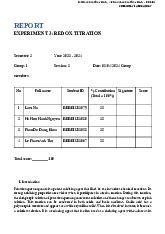



Preview text:
Experiment 3: Redox Titration with KMnO4 Mai Quý Khang BTFTIU22049 I. Purpose General purpose
Learn about the term of gram equivalent weight.
Review of oxidation-reduction reactions.
Standardize the concentration of KMnO4 solution and determine the oxalic acid normality. Applications
Redox titrimetry is used to analyse a wide range of inorganic analytes. A redox titration (also called
an oxidation-reduction titration) can accurately determine the concentration of an unknown analyte
by measuring it against a standardized titrant. Redox titration is used in pharmaceutical analysis
like in the determination of valganciclovir hydrochloride (VLGH) in pure drugs and tablets or used
in industry to establish the purity of raw materials, including binding substances in oral
medications, rather than the end product itself. II. Methods 2.1 Handling with burette
Step 1: Rinse the burette 3 times with distilled water
Step 2: Rinse the burette 3 times with ~5mL KMnO4 Step 3: Discard the waste
Step 4: Fill with KMnO4 and let it drain through the burette tip
Step 5: Record the initial point (preferably up to the average eye level)
2.2 Standardization of prepared KMnO4 solution Section 1: Preparation Prepare ~25mL 0.05N H2C2O4.
Prepare two (02) flasks as follows.
Add sequentially 10mL 0.05N H2C2O4, 40mL distilled water and 20mL 6N H2SO4. Section 2: Titration
Heat the flask to ~85 – 90oC. Record the initial point (Vi) . Add KMnO4 slowly and swirl the flask
continuously. First sign of color change (light pink). Stop titration. Record the final point (Vf).
Calculated VKMnO4 (Vf – Vi). Section 3: Calculation
Calculated the normality of KMnO4 and the average normality and standard deviation.
2.3 Determination of unknown concentration H2C2O4 solution. Section 1: Preparation
Prepare ~25mL of unknown normality H2C2O4.
Prepare two (02) flasks as follows.
Add sequentially 10mL unknown H2C2O4, 40mL distilled water and 20mL 6N H2SO4.
Section 2: Titration with the two prepared flasks.
Heat the flask to ~85 – 90oC. Record the initial point (Vi). Add KMnO4 slowly and swirl the flask
continuously. First sign of color change. Stop titration. Record the final point (Vf). Calculate VKMnO4 (Vf - Vi). Section 3: Calculation
Calculate the normality of unknown concentration H2C2O4 and the average normality and standard deviation.
2.4 Determination of unknown concentration FeSO4 solution Section 1: Preparation
Prepare ~25mL unknown normality FeSO4.
Prepare two (02) flasks as follows.
Add sequentially 10mL unknown FeSO4, 40mL distilled water and add 20mL 6N H2SO4.
Section 2: Titration with the two prepared flasks
Heat the flask to ~85 – 90oC. Record initial point (Vi). Add KMnO4 slowly and swirl the flask.
First sign of color change (light pink). Stop titration. Record the final point (Vf). Calculated VKMnO4 (Vf – Vi). Section 3: Calculation
Calculated the normality of unknown concentration FeSO4 and the avergae normality and standard deviation. III. Safety precations
Acid sulfuric (H2SO4) is one of three inorganic acids with extremely strong chemical properties,
often causing deep burns when in contact with the human body. Due to its strong oxidizing
properties, when acting on the human body, acid destroys tissue structures such as skin, fat, tendons,
muscles... causing necrosis from the outside in according to the body's protein coagulation mechanism. IV. Suggested questions
1. What are the objectives of today's lab work?
Learn about the term of gram equivalent weight.
Review of oxidation-reduction reactions.
Standardize the concentration of KMnO4 solution and determine the oxalic acid normality.
2. What is a redox reaction (oxidation-reduction reaction)?
An oxidation–reduction or redox reaction is a reaction that involves the transfer of electrons
between chemical species (the atoms, ions, or molecules involved in the reaction).
3. In a redox reaction, what are the oxidizing agent and reducing agent?
An oxidizing agent is a substance that causes oxidation by accepting electrons; therefore, it gets
reduced. A reducing agent is a substance that causes reduction by losing electrons; therefore it gets oxidized.
4. Balance the reaction between potassium permanganate (KMnO4) with oxalic acid (H2C2O4)
in the presence of excess sulfuric acid (H2SO4)? Show your work.
2KMnO4 + 5H2C2O4 + 3H2SO4 10CO2 + K2SO4 + 2MnSO4 + 8H2O
2MnO -4 + 5H2C2O4 + 6H+ 10CO2 + 2Mn2+ + 8H2O
5. Please define the gram equivalent weight (GEW) of oxidizing agent and gram
equivalentweight of the reducing agent
One gram equivalent weight (GEW) of oxidizing agent is the weight that gains 6.02x1023 electrons,
and one gram equivalent weight of reducing agent is the weight that loses 6.02x1023 electrons.
GEW of oxidizing = GEW of reducing
6. What is normality? How do you calculate the normality of a solution?
Normality is a measure of concentration that is equal to the gram equivalent weight of solute per
litre of solution. The normality of a solution is equal to the number of gram equivalents divided by
the volume of solution in litres.
7. What is the normality of an 1M H2SO4 solution?
The normality of an 1M H2SO4 solution is 2N.
8. What is the normality of an 1M HCl solution?
The normality of an 1M HCl solution is 1N.
9. What is the titration technique? What is its principle?
Titration is a quantitative chemical analysis. It is used to determine an unknown concentration of
a known substance in a sample. The basic principle of the titration is the following: A solution – a
so called titrant or standard solution – is added to sample to be analyzed.
10. Please watch the following video clip and list out all the steps of titration using a burette. 1. Clean 2. Rinse 3 times 3. Fill 4. Remove bubbles 5. Drain to zero 6. Take initial reading 7. Add indicator 8. Titrate 9. Touch tip and wash 10. Partial drop 11. Take final reading



